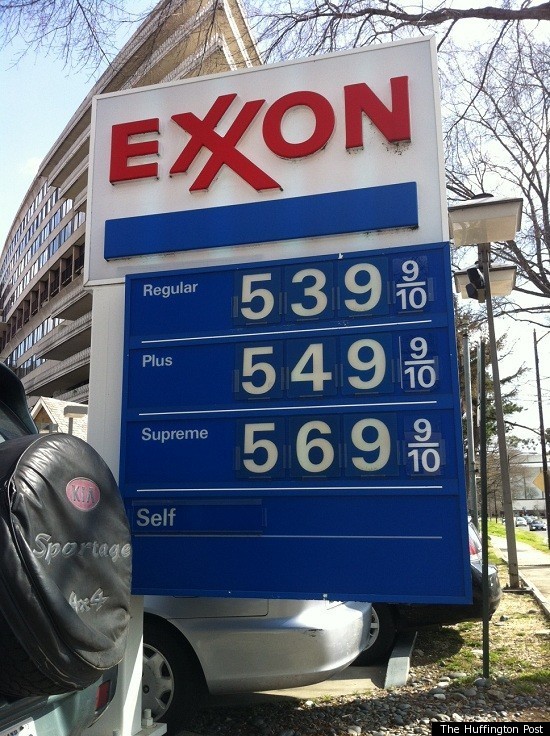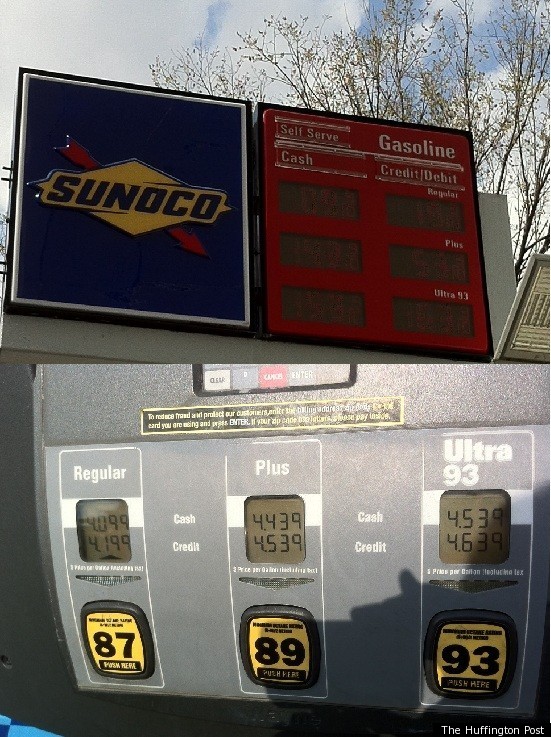
Back in the day, you could typically count on the Weekly Standard to produce long and complicated arguments designed to build the case for getting the United States involved in some costly wars. But with the calls to get out of Afghanistan now coming loudest from Republicans, the Standard is forced to write short blog posts attempting to argue that it's President Barack Obama's fault that the gas prices are too damn high. Today, they did a little enterprise reporting, snapped a picture of an Exxon station "within walking distance of the White House," and created a post titled, "The Shocking Photo the Obama Administration Doesn't Want You to See!"
Of course, the knowledgeable take on the matter is that the president doesn't have much to do with the price of gas. There's a reason why George Will finds this election year argument to be "economic nonsense," and advises against making it. As it happens, Obama's likely opponent, Mitt Romney, agrees. But blaming the resident of the White House for the high price of gas is legitimately one of those things that "both sides do." That's why, back in 2008, Fox News pundits mounted the same arguments that Democratic partisans are mounting now.
The implication made by the Weekly Standard (and I understand that the headline is tongue-in-cheek) is that Obama is somehow "out of touch" with what's going on at ground level, because if he'd only walk out the front door of the White House and down the street, he'd see a gas price crisis a-brewing. At which point, he would -- you know ... do "stuff."
But as it happens, I recognize the Exxon station in the Standard's post. It's the Exxon on Virginia Avenue NW, near the Watergate Hotel. And while I figured I'd be risking adding to the already deep well of blogging in the "almost not worth the effort" genre, it was a nice enough day outside that I figured I'd head on down to that part of town to check it out. Sure enough, what I found were some astoundingly high gas prices:

So -- ya burnt, Barry -- Standard story confirmed, right? Well, not exactly. See, being familiar with that area, I also knew that there was another gas station right across the street from this Exxon. And while the light-up display on its sign confounded my iPhone camera's ability to snap a picture, I was nevertheless able to take stock of what this other station was charging. The results may shock you!

Yes, as it turns out, the prices at the Sunoco station right across the street (and technically closer to the White House) are about $0.90 to $1.30 less per gallon than at the Exxon.
And if you haven't already figured it out, this strange disparity in price at adjacent gas stations turns out to be one of the most well-reported things in Washington. Back in April of 2011, NPR examined the phenomenon and determined that a couple of key factors had figured into the Exxon station's decision to sell gas at the higher price. First, there are quirks in the ways that the roads in the area are designed that make the Sunoco harder to spot and more difficult to get to for most motorists in the area. Second, the Exxon station is also a repair shop, so selling gas isn't something it is uniquely interested in doing. As Dr. Severin Borenstein -- gas price whisperer from U.C. Berkeley -- told NPR, "It's not their main line of business. They're willing to sell gasoline. They have a pump, and they have tanks, but they - it's not where they're primarily focused."
Of course, other reports have ascribed darker motives to this particular Exxon. As the Washington City Paper reported in June of 2011, a dispute between several Exxon owners and their "embattled landlord," Joe Mamo, included an accusation (from Mamo) that Exxon owners in Washington, DC were "engaged in price gouging that’s inflated the citywide average cost of a gallon of gas." All of which leads one to think, "Buyer beware at DC Exxon stations." Of course, we could also just pull this sentence from the City Paper's article: "Summer began this week, which means panic about rising gas prices—an annual tradition in the media—can’t be far behind."
The bottom line here is that there is an Exxon charging an exorbitant rate for gas in Washington. And whether that's due to a trick of the roads, or a quirk in the market, or a conspiracy to drive up prices among renters, the bottom line is that it isn't the fault of any President of the United States.
And here's where I must confess a certain puzzlement with what the Weekly Standard is doing. Want to ding Obama for being out-of-touch and unaware of the high cost of gas near the White House? You know ... fine, I guess. But why not roll up on the Sunoco, where the gas prices are still pretty steep? They just had to go for that little bit of deceptive overreach, grab for that little bit extra, and afford me the opportunity to finely mince their credibility in public.
They literally picked the worst possible gas station in the area to try to make this point. It all could have been avoided!
UPDATE, 3/14/12: The aforementioned Joe Mamo, CEO of Capitol Petroleum Group, LLC, sends along a statement that adds further clarification to why that particular Watergate Hotel-adjacent Exxon charges the high prices it does:
The now “infamous” Exxon gas station on Virginia Avenue in D.C. has attracted media attention lately after charging more than $5.40 per gallon of gas, and has fueled a debate over whether or not the prices were influenced by politics. However, the cause is much more simple – the station is owned by an independent operator who is choosing to charge commercially unreasonable prices to D.C. motorists.
For example, on March 13, 2012, the station posted a price for regular unleaded gasoline of $5.399 per gallon. The station operator paid only $3.81 per gallon (including taxes), making a whopping $1.58 profit per gallon. Compare that to the national average profit margin for gasoline retailers of 16 cents per gallon (according to the National Association of Convenience Stores). That makes the profit for the Virginia Avenue gas station almost 10 times the national average. The competing Sunoco station directly across the street, on the same day, posted a regular unleaded price that was $1.20 per gallon lower.
The difference is that the Sunoco station (like some other stations in the District) is operated by a wholesale distributor of gasoline, and these distributor-run stations typically post lower retail prices than those operated by independent dealers. Therefore, it’s no coincidence that the Virginia Avenue Exxon is leading the charge to outlaw distributor-operated stations in D.C. The Exxon operator, along with a few other high-priced D.C. station operators, were assisted in this effort by D.C. Councilwoman Mary Cheh. She sponsored a bill in the City Council that would have prohibited distributor-operated stations in D.C. and the competition they pose to dealers, like the one that operates the Virginia Avenue Exxon station. Fortunately, the legislation was defeated last month, and distributors are still allowed to compete for business in the District. So while the astronomical price of gas at the Virginia Avenue Exxon is not due to politics, the operator of that station and others like him, have made this issue political in order to try to perpetuate their ability to charge high prices.
[Would you like to follow me on Twitter? Because why not?]
